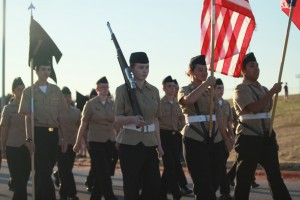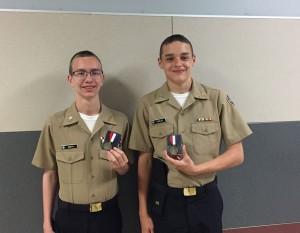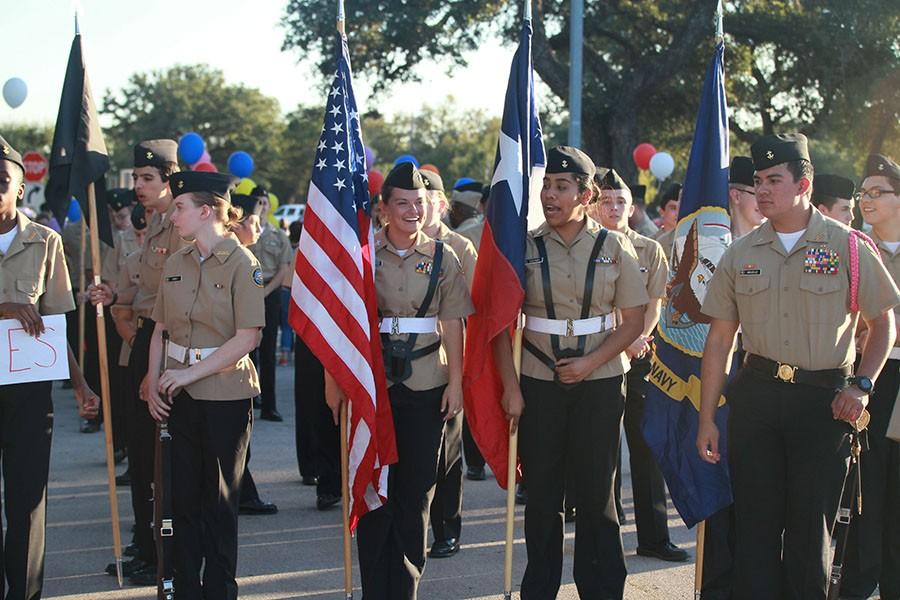Basic Training
More than 50 Navy Junior ROTC students travel between two campuses for military program
Liz Montgomery, Jasmine Acevedo & Addison Abucejo participate in the Homecoming parade.
March 15, 2016
Tan, crisp short sleeve shirts arranged with ribbons. Black dress pants accompany black dress shoes. Dozens of this same uniform flash by as ROTC students hop off the bus to get to class.
For more than 50 students in the Navy Junior ROTC program, wearing the uniform is just one simple part of being in the program.
“I like how it’s very unpredictable when you first walk into it,” freshman Volcano Ramirez-Ford said. “Everyone is there to help you out with things because with uniforms it’s hard for beginners to get used to the whole uniform thing like how to put it on and how to wear your ribbon bar. You have mentors, which are the upperclassmen which help you out and remind you if there’s a uniform day, inspection day, or P.T. day where we need our equipment.”
NJROTC stands for Naval Junior Reserve Officer Training Corps. Rouse students in the program attend Vista Ridge for at least two periods on A days, with drill practice or personal training starting at 8:40 a.m.
“I wanted to join ROTC and the military because I want a purpose,” freshman Cameron Hawkins. “And to protect the country.”
Supply officers, executive officers and commander officers help run the ROTC units. Supply officers organize the uniforms and the supplies they need, executive officers assist commanding officers, and commanding officers keep everyone in order.

“I probably want to be supply officer,” sophomore Rebecca Kirby said. “I feel like I exhibit leadership and I keep things pretty organize, so I think I could be a good example and I can just help people find their stuff and know what to do when it comes to the supply room.”
ROTC members can add ribbons to their uniforms by attending certain events and completing tasks.
“I don’t have any ribbons right now,” Ramirez-Ford said. “My friends do and some of their ribbons were from first orientation ribbon and people have to go to during the summer for it and the ribbon is for showing up to the orientation. It tells the student more about ROTC and they issue their first uniform. There’s a participation ribbon and that’s when you go to two events outside of school that has to do with NJROTC, there’s an orienteering ribbon that’s held at St. Edwards, I think. And what you do is orienteer for the first time and basically it’s where you have a map and a compass and a team and you basically try to find your way out of the woods, that’s your objective.”
In addition to their ROTC classes, the students in the program also participate in activities outside of class like volunteering. They have cleaned up Veterans Memorial Park and a road near Vista Ridge, and donated food at Capital Area Food Bank.

“It’s helpful,” freshman Sydney Nauert said. “For me I do a lot of volunteer work and so it helps to achieve goals I have. I want to be a pediatric nurse so I want to care for others, so the volunteer work helps me for that.”
Wednesday, the entire Navy ROTC went through the annual military inspection. The inspection makes sure they’re operating up to standards and they got the highest scores. They do drills and armed and unarmed team performance. Ten percent of the class received the Area 10 Bravo Zulu medal.
“It was pretty great,” cadet petty officer 1st class Kenneth Smith said. “It was pretty cool, when you’re in the top 10 percent, it’s nice to get recognition in front of everyone for all the work you’ve done.”
ROTC isn’t just for people who want to serve in the military. It’s for the people who want to make a difference in their community.
“To me ROTC means integrity and honor,” Kirby said. “Like it’s kind of hard to explain, but it’s kind of like this sacred trust that you have that when you’re put into the unit and you put on the uniform it represents all of the people you have fought and died before you and have given you the freedom to do what you want in this day and age, this is why I wanted to join. I also want to join the Navy after high school so I joined for that reason.”



